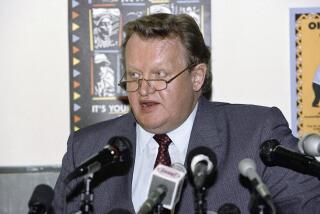Ex-Finnish President Urho Kekkonen, 85, Dies
- Share via
HELSINKI, Finland — Former President Urho Kekkonen, an architect of the policy of cooperation with the neighboring Soviet Union that came to be known as “Finlandization,” died early today at age 85, his family announced.
Kekkonen, one of Europe’s elder statesmen, who was instrumental in the signing of the 1975 Helsinki accords, was president of Finland from 1956 until he stepped down because of ill health in 1981. He would have been 86 Tuesday.
The brief family bulletin said he died from the effects of a hardening of the blood vessels, which caused circulation troubles in the brain.
He had been living in seclusion since he retired from the presidency on Oct. 27, 1981.
Kekkonen dedicated his life to preserving Finnish independence. His career as prime minister and later president spanned 30 years.
The West coined “Finlandization” as a derogatory term for the limits placed on Finland’s independence by its 1944 defeat at the end of a war with the Soviet Union fought over territorial issues.
Kekkonen took the term as a compliment, however, arguing that Finland had achieved a model balance in managing to hang on to the traditions of Western parliamentary democracy, while at the same time winning Moscow’s trust.
He was prime minister five times between 1950 and 1956, the year in which he was first elected to the presidency.
He was a prominent European statesman and champion of world peace. Among his main achievements was calling the European security conference, which set the seal on the postwar boundaries of Europe and produced the 1975 Helsinki agreement, the crowning work of detente.
Urho Kaleva Kekkonen was born the son of a sawmill foreman in Pielavesi, central Finland, on Sept. 3, 1900. In 1926 he married Sylvi Uino, daughter of a Lutheran minister. They had twin sons.
More to Read
Sign up for Essential California
The most important California stories and recommendations in your inbox every morning.
You may occasionally receive promotional content from the Los Angeles Times.












